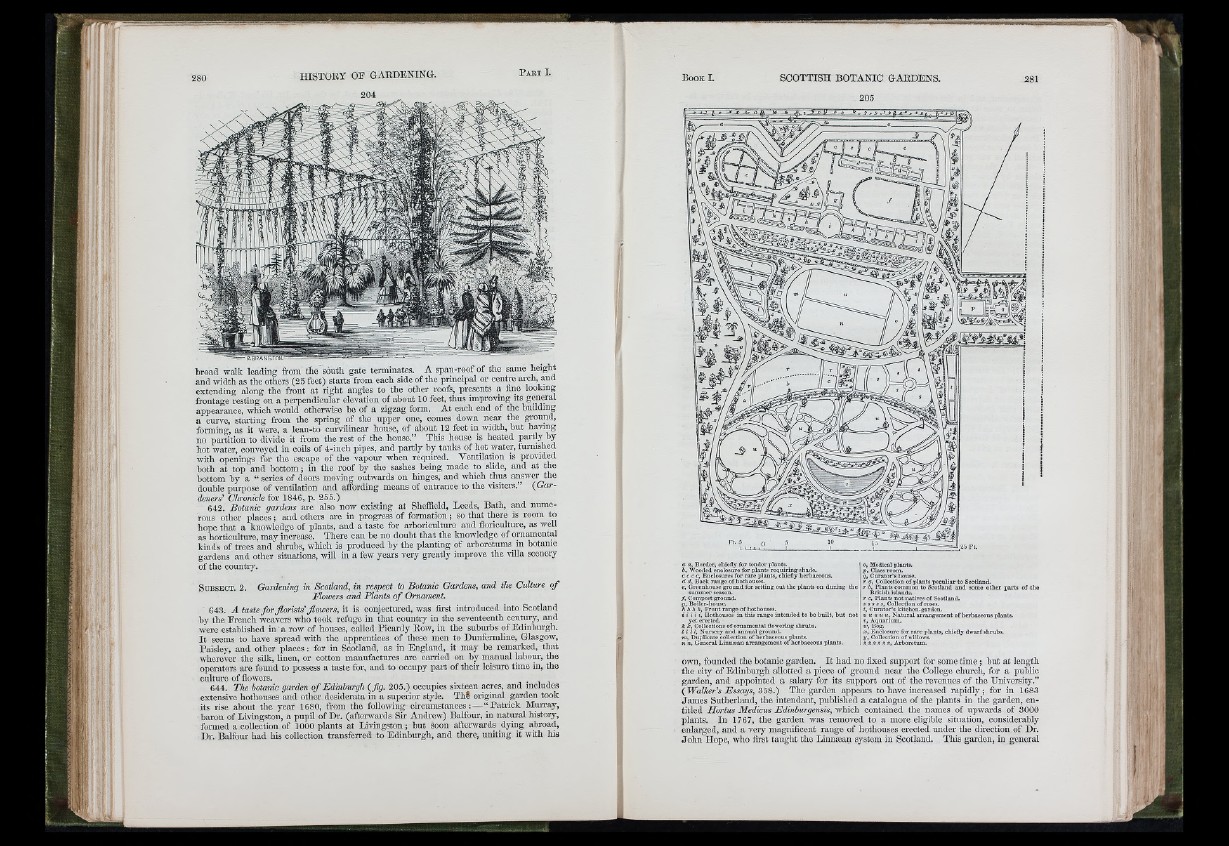
f t ' .
f t
broad walk leading from tíic áónth gate terminates. A span-roof of the same ¡jeigbt
and width as the others (25 feet) starts from each side of the principal or centre arch, and
extending along the front at right angles to the other roofs, presents a fine looking
frontage resting on a perpendicular elevation of about 10 feet, tbus improving its general
appearance, which would othenvise be of a zigzag form. A t each end of the building
. cui-ve, starting from the spring of the upper one, comes down near the ground,
forming, as it were, a lean-to curvilinear house, of about 12 feet in width, but having
no partition to divide it from the rest of the house.” This house is heated partly by
hot water, conveyed in coils of 4-inch pipes, and partly by tanks of hot water, furnished
with openings for the escape of the vapour when required. Ventilation is provided
both at top and b o ttom ; in tbe roof by the sashes being made to slide, and at the
bottom by a “ series of doors moving outwards on hinges, and which thus answer the
double purpose of ventilation and affording means of entrance to the visiters.” (G a rdeners’
Chronicle for 1846, p. 255.)
642. Botanic gardens are also now existing at Sheffield, Leeds, Bath, and numerous
other pla ces; and others are in progress of formation; so that there is room to
hope that a knowledge of plants, and a taste for arboriculture and floriculture, as well
as horticultui-e, m ay increase. There can be no doubt that the knowledge of ornamental
kinds of trees and shrubs, which is produced by the planting of arboretums in botanic
gardens and other situations, will in a few years very greatly improve the villa scenery
of the country.
SuBSECT. 2 . Gardening in Scotland, in respect to Botanic Gardens, and the Culture o f
Flowers and Plants o f Ornament
643. A taste fo r florists’ flowers, it is conjectm-ed, was first introduced into Scotland
by the French weavers who took refuge in that countiy in the seventeenth century, and
were established in ' a row of houses, called Picai’dy Row, in the suburbs of Edinburgh.
I t seems to have spread with the apprentices of these men to Dunfermline, Glasgow,
Paisley, and other pla ces: for in Scotland, as in England, it may be remarked, that
wherever the silk, linen, or cotton manufactures are carried on by manual labour, the
operators are found to possess a taste for, and to occupy part of their leisure time in, the
culture of flowers. _ _ . , ,
644. The botanic garden o f Edinburgh 205.) occupies sixteen acres, and includes
extensive hothouses and other desiderata in a superior style. Th6 original garden took
its rise about the year 1680, from the following circumstances:— “ Patrick Murray,
baron of Livingston, a pupil of Dr. (aftenvards Sir Andrew) Balfour, in natural history,
formed a collection of 1000 plants at Livingston; but soon afterwards dying abroad.
Dr. Balfour had his collection transferred to Edinbui-gh, and there, uniting it with Ms
a ft, Border, chiefly for tender plants.
*, Wooded enclosure for plants requiring shade,
c c c c. Enclosures for rare plants, chiefly herbaceous.
d cl. Back range of hotliouses.
e, Greenhouse ground for setting out the plants on during the
summer season.
J, Compost ground.
g. Boiler-house.
kkJth, Front range of hothouses.
t i t i J, Hothouses in this range intended to be built, but not
yet erected.
k £, Collections of ornamental flowering shrubs.
II II, Nursery and annual ground.
0, Medical plants.
p. Class room.
g, Curator’s liouse.
r a , Collection of plants peculiar to Scotland.
r b. Plants common to Scotland and some other parts of tho
British islands,
r c, Plants not natives of Scotland.
s 3 s s s. Collection of roses.
t. Curator’s kitchen-garden.
u tf u M «, Natural arrangement of herbaceous plants,
t), Aquarium.
w. Bog.
a:, Enclosure for rare plants, chiefly dwarf shrubs.
y. Collection of willows.
. z z z z z z . Arboretum.
own, founded the botanic garden. I t had no fixed support for some tim e ; but at length
the city of Edinburgh allotted a piece of ground near the College church, for a public
garden, and appointed a salary for its support out of tbe revenues of the University.”
(Walker’s Essays, The garden appeal's to have increased rapidly; for in 1683
James Sutherland, the intendant, published a catalogue of the plants in the garden, entitled
Hortus Medicus Edinburgensis, wliich contained the names of upwards of 3000
plants. In 1767, the garden was removed to a more eligible situation, considerably
enlarged, and a very magnificent range of hothouses erected under the direction of Dr.
Jo h n Hope, who first taught the Linnecan system in Scotland. This garden, in general
a